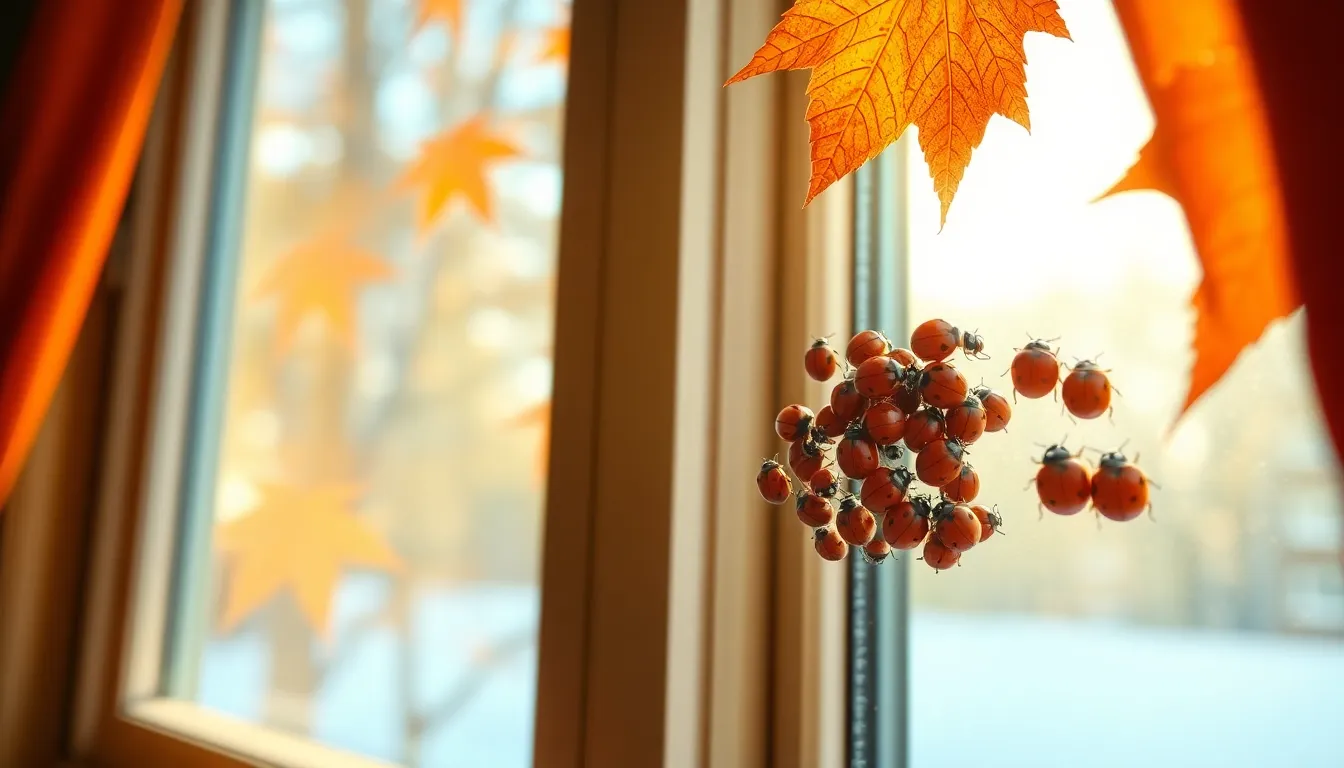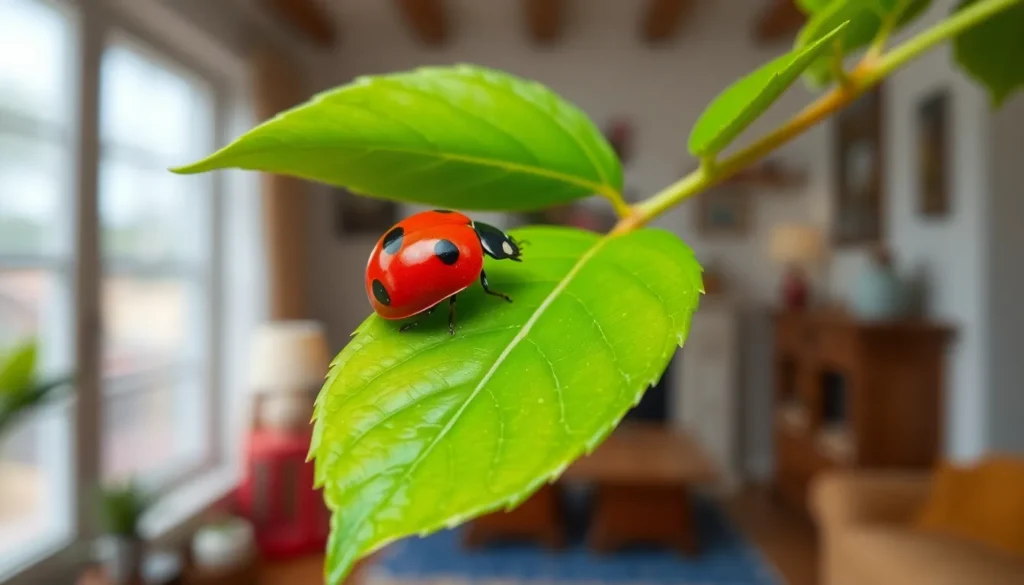Table of Contents
ToggleFinding ladybugs in the house can be a curious and somewhat charming surprise. These tiny beetles, often associated with good luck, have a knack for sneaking indoors, especially during the colder months. But why do they choose your home as their winter retreat?
Ladybugs typically seek shelter in warm, cozy spaces to escape the harsh weather outside. They’re not just looking for a place to stay; they’re also searching for food sources like aphids and other pests. Understanding their behavior can help homeowners manage these uninvited guests while appreciating their role in the ecosystem.
Understanding Ladybugs
Ladybugs are small, colorful beetles known for their distinctive appearance and beneficial role in ecosystems. Understanding their behavior and characteristics can help homeowners manage their presence indoors.
Overview of Ladybug Species
Ladybugs belong to the family Coccinellidae, featuring approximately 5,000 species worldwide. The most common types include the convergent ladybug, the seven-spotted ladybug, and the multicolored Asian lady beetle. Each species displays unique color patterns and behaviors, typically characterized by a round body and spots. These beetles vary in size, with most measuring between 0.8 to 18 millimeters in length. By recognizing different species, individuals can identify which ladybugs visit their homes.
Benefits of Ladybugs in Gardens
Ladybugs offer several benefits in garden settings. They consume pests like aphids, mites, and whiteflies, making them effective natural pest control agents. Studies show a single ladybug can eat up to 5,000 aphids in its lifetime. Additionally, ladybugs contribute to pollination, enhancing plant growth and productivity. Their presence can lead to improved biodiversity, benefiting overall garden health. Homeowners might find that attracting ladybugs can result in a more thriving and balanced garden ecosystem.
Reasons Ladybugs Enter Homes

Ladybugs often enter homes for specific reasons, particularly during seasonal transitions. Understanding these factors can assist homeowners in managing their presence effectively.
Seasonal Changes and Migration
Seasonal changes trigger the migration of ladybugs. As temperatures drop in autumn, ladybugs seek a warm environment for survival. They typically travel in groups, often targeting crevices or openings in homes to escape the cold. This behavior appears most prominently in late fall, when ladybugs look for shelter. Additionally, some species exhibit a tendency to move indoors preemptively, anticipating winter’s arrival.
Seeking Shelter from Weather
Ladybugs also seek shelter from inclement weather. Harsh conditions, including rain and snow, prompt them to find a safe environment. Homes provide a regulated climate, protecting these beetles from extreme temperatures and precipitation. Cracks around windows, doors, and walls often serve as entry points. Once inside, ladybugs tend to cluster around warm areas, such as sunny windowsills, maximizing their chances of survival through adverse weather.
Common Signs of Ladybug Infestations
Recognizing the signs of a ladybug infestation can help homeowners address the issue efficiently. Various indicators reveal the presence of these beetles within the home.
Identifying Ladybug Presence
- Sightings on Walls and Windows: Ladybugs often appear on walls and near windows, particularly on sunny days. They gather in clusters, making their presence noticeable.
- Excrement Spots: Small, dark, round spots may be found in areas where ladybugs reside. This excrement resembles tiny specks and can indicate a significant population.
- Shedding Exoskeletons: Empty exoskeletons may be discovered in locations where ladybugs gather. These remnants showcase their life cycle stages and confirm prolonged infestations.
- Noise: A faint rustling sound might be audible as ladybugs move around, especially when disturbed. This subtle noise can help in identifying their presence.
Distinguishing from Other Insects
- Coloration: Ladybugs typically exhibit bright red or orange bodies with contrasting black spots. Other similar insects may lack this distinctive color pattern.
- Body shape: Ladybugs have a rounded, dome-shaped appearance. In contrast, other beetles, like boxelder bugs, appear elongated and have different physical features.
- Size: Most ladybugs range from 0.8 to 0.4 inches in length. Other household insects may vary in size, helping to differentiate ladybugs from them.
- Behavior: Ladybugs often congregate in warm areas, unlike many other pests that may spread throughout the home in search of food sources. This clustering behavior serves as a key identifying trait.
By monitoring these signs and characteristics, homeowners can efficiently determine the presence of ladybugs and differentiate them from other insects.
Prevention and Control Methods
Implementing effective measures can help keep ladybugs outside homes. Understanding their behaviors and preferences is crucial in limiting their access.
Keeping Ladybugs Outside
Sealing home entry points prevents ladybugs from intruding. Inspect and repair gaps around windows, doors, and vents. Weatherstripping provides an effective barrier. Install screen mesh on windows and vents to allow airflow while blocking insects. Keep exterior lights off or use yellow bulbs, as these attract fewer insects. Regularly clean outdoor areas, removing debris and leaves that serve as congregating spots for ladybugs.
Natural Deterrents
Utilizing natural deterrents can discourage ladybugs from entering homes. Essential oils such as peppermint, clove, and citronella repel ladybugs when applied near entry points. Mix a few drops of essential oil with water in a spray bottle, then apply around windows, doors, and crevices. Alternatively, consider planting marigolds or chrysanthemums outside; these flowers emit scents that deter ladybugs and other pests. Additionally, introducing predatory insects, such as lacewings, reduces the aphid population, thereby decreasing ladybug attraction to the area.
Ladybugs may find their way into homes during colder months as they seek warmth and shelter. Understanding their behavior helps homeowners manage these beneficial insects while appreciating their role in natural pest control. By taking preventive measures and creating a welcoming outdoor environment, it’s possible to keep ladybugs outside where they thrive. Recognizing the signs of their presence and knowing how to differentiate them from other pests can aid in maintaining a balanced ecosystem. Embracing ladybugs not only supports garden health but also fosters a deeper connection with nature.




